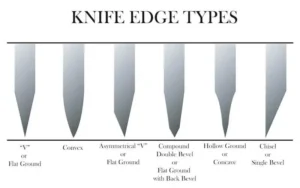Cutting edges that you can sharpen and hone with a Block sharpener.
V-edge 
The V-edge is the most common style for kitchen knives. Like the letter V, these blades slant directly from the spine to the edge at a symmetric angle.
V-edges are the preferred design for most kitchen knife makers as they are easy to sharpen and hold their edge longer, though durability is sacrificed in favor of a fine edge.
Double bevel or Compound Edge
A double beveled edge, also known as a compound edge, is essentially a double-layered V-edge. Picture a large V with a smaller V on top of it. This is my favorite overall. It’s sharp and durable.
The secondary bevel, also known as a relief angle, serves to make the metal behind the edge thinner. In principle, a thinner-edged blade has a greater cutting ability given its lack of friction—but it is also more likely to sustain damage.
The idea behind a double bevel is to make the edge stronger and more resistant to rolling and cracking with the support of the secondary bevel.
A couple of Chef’s Choice knife sharpeners work this way—The M1520 and the M120 for example.
Chisel edge
Chisel edges are most commonly found on Japanese sushi knives like Santokus and Nakiris.
These blades are only ground on one side to form a single primary bevel, while the other side is left straight and flat. For this reason, chisel edge knives can be found in both left-handed and right-handed varieties.
The edge is usually sharpened between 20º and 25º, which comprises the total angle of the edge (the flat side has an angle of 0). Such an acute angle makes chisel edges exceptionally thin and sharp compared to most American and European knives.
This design makes chisel edge knives the preferred style for cutting delicate raw fish in sushi restaurants.
Convex edge
Convex edge blades feature two outward arcs that slope in and intersect at the edge. The resulting look of the edge resembles the slope of an airplane wing.
The curved design puts more steel behind the edge, making it stronger and sharper than V-edged blades.
Since the creation of a convex edge is a bit more sophisticated than others, they can be more difficult to sharpen effectively with home sharpeners. Because of this, convex edges often lose their shape and are eventually shaved down to V-edges.
Hollow edge
Hollow edge blades, also known as concave edges, curve inward–the opposite direction of convex edges.
These blades can get very sharp, are usually reserved for hunting and survival knives.
Some bargain-brand butcher knives may employ a hollow edge, but most quality kitchen sets will feature a stronger V-edge.
Serrated edge- sharpens any style serrated edge.
Like chisel edges, serrated-edged blades are ground on only one side. The distinguishing features of serrated edges are the mini-arches, or teeth, that serve to protect the actual cutting surface and keep the edge sharp. block sharpener will sharpen any serrated edge knife.
See how we do it videos. https://youtu.be/fxcvlOy3fNc
You will find with our unique flex design in our sharpener handle you can sharpen many different types of cutting edges. Like all V -shaped edges form 16 degrees threw 28 degrees, convent edges, serrated edges, scissor edges and odd shaped blades like found on snake shaped daggers or hawkbill work knife.








